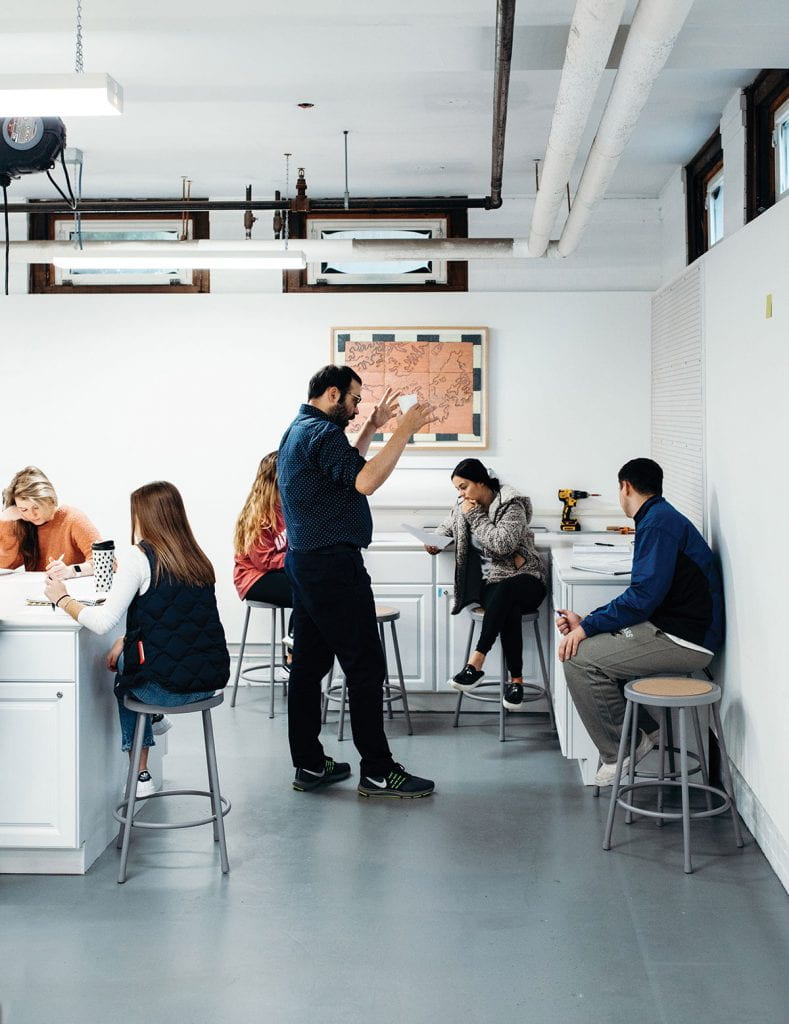Business Innovation Program benefits from new maker space
By Chris Machado
Discover by doing. Connect through collaborating. Solve through sharing.
These are key components to entrepreneurship and innovation. And, this is what Providence College students are doing in a new Design Thinking Lab and Collaboration Space in the Service Building — within the College’s “Arts District” on East Campus.
The space is used for the Design Thinking & Innovative Problem Solving course, which is a requirement for students in the new minor in Business Innovation Program (B&I). The fast-growing program has four tracks — Organizations and Entrepreneurs, Global Engagement, Applied Science, and Design Thinking.

Eric E. Sung, associate professor of photography, B&I Program director, and the faculty sponsor for the Design Thinking track, said the new space — along with the course and the B&I minor — emphasizes the growing need to transform ideas into tangible outcomes.
“Design thinking means far more than ‘graphic design’ or ‘furniture design.’ It has more to do with problem-solving to improve the quality of human lives,” said Sung. “Many of the problems we experience are not new, and we have the resources to address these problems. In the history of human learning, we have been so good at incubating ‘experts’ in all areas, but now we are in need of thinkers who are capable of connecting dots to weave through all of this expertise.”
The two-room Design Thinking Lab and Collaboration Space is, at once, sophisticated and intentionally uncomplicated. In one room, there are more than 16 iMac Pro computers and large-format printing capabilities. In the other, there are unadorned collaboration tables where students brainstorm ideas and create prototypes.
Ashley Gigon ’22 (Spring Lake, N.J.), a pre-engineering major and B&I minor, was a student in the first class to use the space in fall 2019. During each class, Gigon said students would start off in the computer lab before moving to the collaboration room to brainstorm. Once those ideas were agreed upon, the students would toggle between the two rooms. They used the computer lab for research and to create digital designs using Adobe Creative Suite (Photoshop, Illustrator, and InDesign), and they used the collaboration room to display prototypes and discuss next steps.
As a pre-engineering student, she said the course was an eye-opening experience that gave her a glimpse of how “different kinds of courses … connect to my major.”
“From a broad perspective, the class was very helpful because students from different backgrounds and majors came together to work on a common project,” she said. “The space was perfect for the class because it allowed us to collaborate and visually see progress toward a final goal.”
From Sung’s perspective, Gigon perfectly captures the essence of the space and the course.
“This is a maker space where students learn how to problem-solve by researching, making, building, articulating, and sharing,” he said. “In this case, the digital component allows students to be fluent with the digital language and resources, while collaborating helps students to effectively communicate with others to co-create ways to address problems. Learning experiences have to be multidimensional because human experiences are multidimensional, and they are the key to problem-solving.”
Please consider a gift to The Fund for Providence College to make it possible for all students to continue to experience the value of a PC education.
support emergency student need




